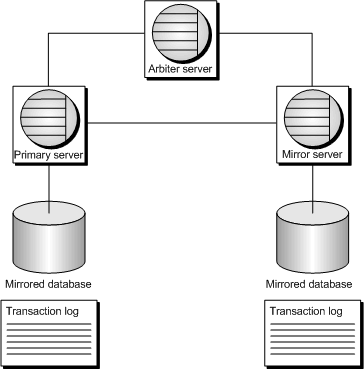Database mirroring requires a separate license. See Separately licensed components.
Database mirroring is a configuration of either two or three database servers, running on separate computers, that co-operate to maintain copies of the database and transaction log files.
The primary server and mirror server each maintain a copy of the database files and transaction log files, while the third server, called the arbiter server, is used when it is necessary to determine which of the other two servers can take ownership of the database. The arbiter does not maintain a copy of the database. The configuration of three database servers (the primary, mirror, and arbiter servers) is called a mirroring system, and the primary and mirror servers together are called the partner servers.

Clients connect to the primary server to access the database. Any changes that are made to the database are recorded in the transaction log on the primary server. When the changes are committed, the transaction log pages are sent to the mirror server where they are applied to a mirror copy of the database. The copy of the database on the mirror server can only be accessed in read-only mode while that server is acting as the mirror server. See Configuring read-only access to a database running on the mirror server.
If the primary server becomes unavailable because of hardware or software failure, the mirror server negotiates with the arbiter to take ownership of the database and assume the role of primary server. For an ownership transfer, or role switch, to take place, the surviving partner server and the arbiter must agree that the mirror was in a current, synchronized state at the time the role switch is attempted. Any clients that were connected to the original primary server are disconnected, and any uncommitted transactions are lost. Clients must then reconnect to the database on the new primary server to continue accessing the database. When the original primary server becomes available again, it assumes the role of mirror server.
The database servers display status messages in the database server messages window on startup to indicate which role the server is assuming and how far the startup process has progressed. A message appears if the database must be restarted because of the loss of one or more of the other servers in the mirroring system, or if its role changes from mirror to primary.
If an assertion failure occurs on a server that is part of a mirroring system, the server writes the error to the database server message log and then exits. This notifies the other servers that it has failed so that they can take appropriate action.
There are no special hardware or software requirements for database mirroring, and the database servers can be running in separate geographical locations. Database servers that are participating in a database mirroring system can run both mirrored and non-mirrored databases. As well, the arbiter server can be the arbiter for multiple database mirroring systems.
If a database involved in a high availability environment encounters a problem, such as an incompatible or mismatched transaction log, it is stopped. The database server running the problem database also shuts down unless there are other databases running on it.
Details about the state of each database in the database mirroring system are stored in a state information file. See State information files.
Database mirroring is not a replacement for a backup and recovery plan. You should always implement a backup and recovery strategy for your database. See Database mirroring and backups and Backup and data recovery.
For information about upgrading SQL Anywhere or rebuilding a database involved in a database mirroring system, see Upgrading SQL Anywhere software and databases in a database mirroring system.
 Quorum
Quorum Restrictions
Restrictions Considerations when developing applications
Considerations when developing applications Upgrading SQL Anywhere
Upgrading SQL Anywhere See also
See alsoBenefits of database mirroring
Arbiter server
Database mirroring modes
 |
Discuss this page in DocCommentXchange.
|
Copyright © 2012, iAnywhere Solutions, Inc. - SQL Anywhere 12.0.1 |